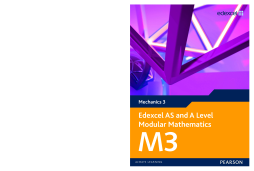
Additional Information
Book Details
Abstract
Edexcel's own course for the GCE specification. Providing the best match to the specification, this book motivates students by making maths easier to learn. Written by chief examiners, it provides student-friendly worked examples and solutions, leading to a wealth of practice questions. Sample past exam papers are included for thorough exam preparation, and regular review sections help to consolidate learning. Opportunities for stretch and challenge are presented throughout the course, and an interactive FREE LiveText CD-ROM contains everything students need to motivate and prepare themselves. The all new Exam Cafe gives students revision advice, key ideas summaries and an abundance of exam practice, with hints and tips.
Table of Contents
| Section Title | Page | Action | Price |
|---|---|---|---|
| Front Cover | Front Cover | ||
| Contents | ii | ||
| About this book | iv | ||
| Chapter 1: Further kinematics | 1 | ||
| 1.1: Using calculus for a particle moving in a straight line with acceleration that varies with time | 2 | ||
| 1.2: Using calculus for a particle moving in a straight line with acceleration that varies with distance | 9 | ||
| Chapter 2: Elastic strings and springs | 19 | ||
| 2.1: Using Hooke’s law to solve equilibrium problems involving elastic springs or strings | 20 | ||
| 2.2: Using Hooke’s law to solve dynamics problems involving elastic strings or springs | 26 | ||
| 2.3: Finding the energy stored in an elastic string or spring | 28 | ||
| 2.4: Solving problems involving elastic energy using the conservation of energy principle and the work–energy principle | 30 | ||
| Chapter 3: Further dynamics | 37 | ||
| 3.1: Using calculus to apply Newton’s laws to a particle moving in a straight line when the applied force is variable | 38 | ||
| 3.2: Using Newton’s law of gravitation to solve problems involving a particle moving away from (or towards) the Earth’s surface | 45 | ||
| 3.3: Solving problems about a particle which is moving in a straight line with simple harmonic motion | 48 | ||
| 3.4: Investigating the motion of a particle which is attached to an elastic spring or string and is oscillating in a horizontal line | 57 | ||
| 3.5: Investigating the motion of a particle which is attached to an elastic spring or string and is oscillating in a vertical line | 63 | ||
| Review Exercise 1 | 75 | ||
| Chapter 4: Motion in a circle | 86 | ||
| 4.1: Calculating the angular speed of an object moving in a circle | 87 | ||
| 4.2: Calculating the acceleration of an object moving on a horizontal circular path | 89 | ||
| 4.3: Solving three-dimensional problems about objects moving in horizontal circle | 95 | ||
| 4.4: Using vector notation to describe motion in a circle | 101 | ||
| 4.5: Solving problems about objects moving in vertical circles | 102 | ||
| 4.6: Solving problems where an object does not have to stay on the circle | 108 | ||
| Chapter 5: Statics of rigid bodies | 118 | ||
| 5.1: Finding the centre of mass of a lamina using calculus | 119 | ||
| 5.2: Finding the centre of mass of a uniform solid of revolution using symmetry and calculus | 128 | ||
| 5.3: Solving problems about rigid bodies which are in equilibrium | 137 | ||
| 5.4: Determining whether a body will remain in equilibrium or whether equilibrium will be broken by sliding or toppling | 144 | ||
| Review Exercise 2 | 155 | ||
| Examination style paper | 170 | ||
| Answers | 172 | ||
| Index | 179 | ||
| Back Cover | Back Cover |
